On View
A Sharp New Show Highlights The Many Ways Artists Have Woven Meaning Into Textiles
“Spin A Yarn” comes to East Hampton's Guild Hall after making a splash in Chelsea.
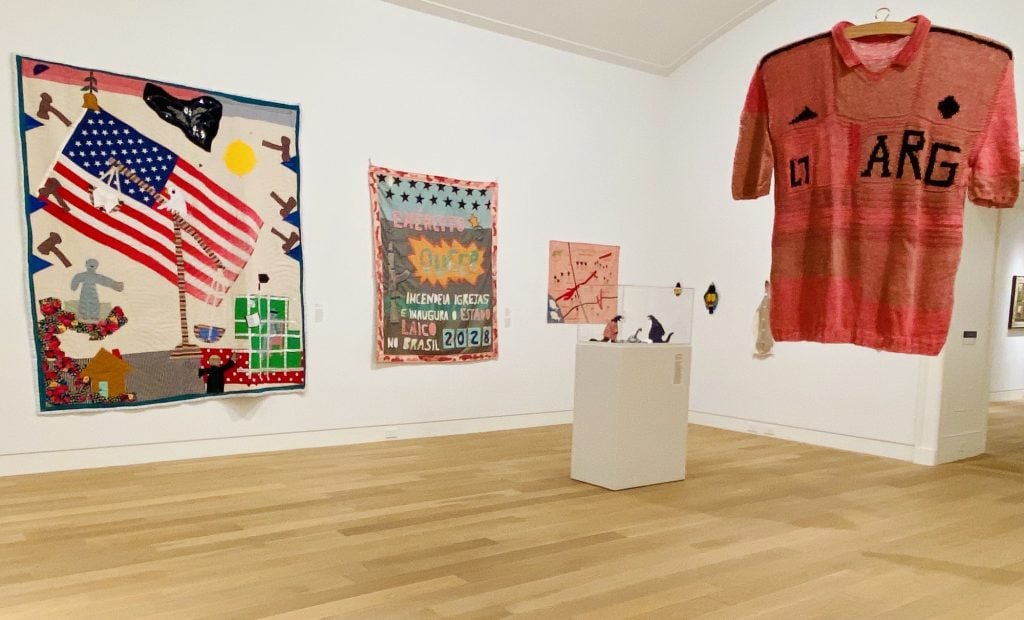
“Spin A Yarn” comes to East Hampton's Guild Hall after making a splash in Chelsea.

Eileen Kinsella

Just in time for the summer crowds to descend on the Eastern End of Long Island, Guild Hall in East Hampton has opened an intriguing show of textile art, organized by collector and art historian Estrellita Brodsky and Raul Martinez. The artists in it are all handpicked, mostly from her own collection.
“Spin A Yarn,” had its debut at Brodsky’s own nonprofit art space in Chelsea, the appointment-only “Another Space,” where she welcomed visitors and numerous student groups from nearby schools for educational tours during its four-month run (November 10, 2023-March 15, 2024). At Guild Hall, the show is open to the public with free admission and related workshops, through July 14.
“Spin A Yarn” examines artists’ interest in textile-making “as both subject and medium to reflect on social, political and environmental concerns,” according to a statement. Brodsky notes that while Western cultures have historically prioritized the written word, many societies, and particularly those in Latin America, have rich traditions of using threads, knots, and woven materials, as markers of identity and as a means of passing down information from one generation to another. The mostly fiber artwork on view is by more than two-dozen artists from different regions and periods.
In conversation, Brodsky noted that textiles have played an important role in preserving memories and traditions. “We explore the ways in which artists have built on rich textile traditions from pre-Hispanic cultures as precursors of geometric abstraction to present day contemporary artists who use embroidery and weaving techniques as a means of advocating for the protection of the environment as well as of indigenous communities,” she said.
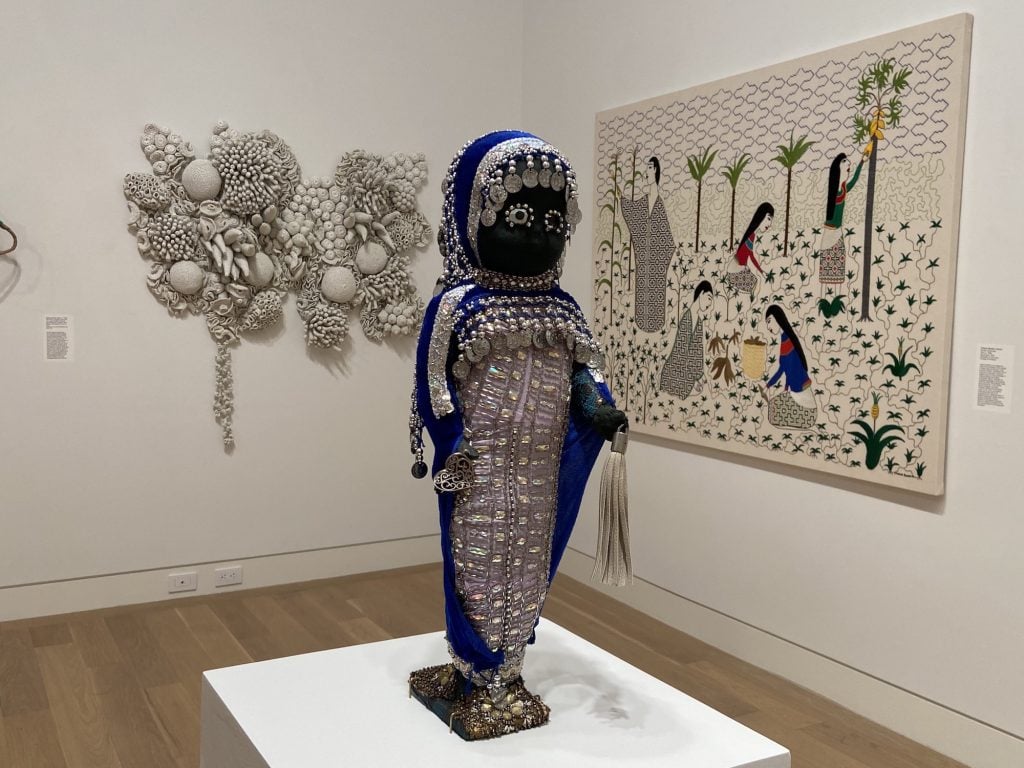
Front: Dubreus Lherisson Blue Princess, (2018) Left: Mulyana Betty 10, (2022) Right: Chonon Bensho Wai (Farm), (2023) as part of “Spin A Yarn” at Guild Hall in East Hampton, New York.
The show includes work by Claudia Alarcón, Olga de Amaral, Tony Bechara, Chonon Bensho, Feliciano Centurión, DETEXT, Jorge Eielson, Mónica Giron, Sonia Gomes, Sheila Hicks, Huari Culture, Jessie Homer French, Randolpho Lamonier, Julio Le Parc, Dubreus Lherisson, Mulyana, Anna Perach, Alejandro Puente, Mónica Millán, Manfred Mohr, Sandra Monterroso, Societé Réaliste, Susan Spangenberg, Pedro Tineo, Georges Valris, Cecilia Vicuña, and Yvonne Wells.
One fascinating and unexpected aspect that Brodsky highlighted to me, during a walkthrough of the show in Chelsea, is the connection between computers and textiles as ways to store and code information. As the show’s statement explains, “the punch cards used in some looms to control the weaving process are the basis of computers’ binary logic.”
For example, Manfred Mohr’s P-159-B from 1974 shows a sequence of intricately stitched geometric forms that evoke “an unknown arcane language,” generated by algorithms. Mohr, a leader in the concept of “rational aesthetics,” underscores the “ancient relationship between textiles and mathematical computer programming,” Brodsky told me.
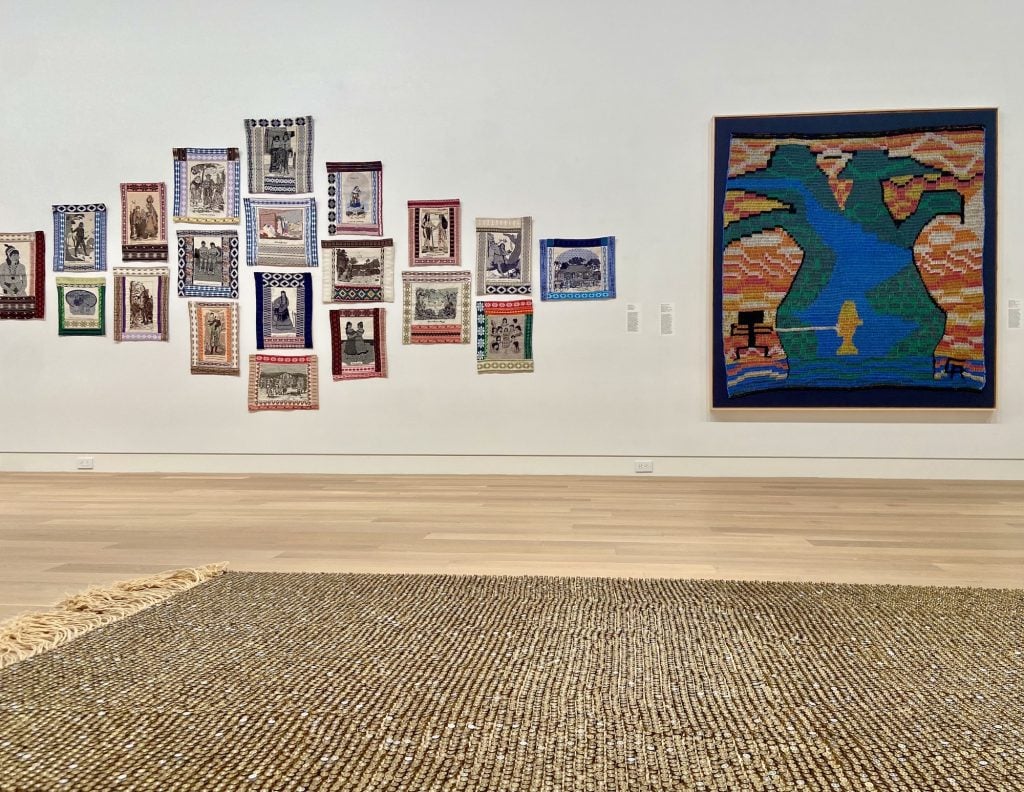
Front: DETEXT (Raul Martinez) Manstopper, (2015). Left to right: Mónica Millán, Inventar la piel (To invent skin), (2023); Claudia Alarcón, Tewok Tes P’ante (The Origin of the River), (2023), as part of “Spin A Yarn” at Guild Hall in East Hampton, New York.
Many of the works here show modern and contemporary artists using indigenous textile techniques to reflect on environmental, political, or social issues. For instance, Alejandro Puente and Sheila Hicks reference the feather works and weavings of ancient pre-Hispanic cultures to convey a newly imagined language of abstraction. Argentine artist Mónica Millán has worked with Guaraní communities in the town of Yataity del Guairá in Paraguay, and advocates for the preservation of Ao Po’i textile traditions.
Artists Jessie Homer French and Mónica Giron draw attention to the environmental crisis through their use of embroidery and knitting techniques that confront climate change and the loss of biodiversity. Cecilia Vicuña warns of the devastating effects of droughts while also bringing attention to ancient Mayan creation myths.
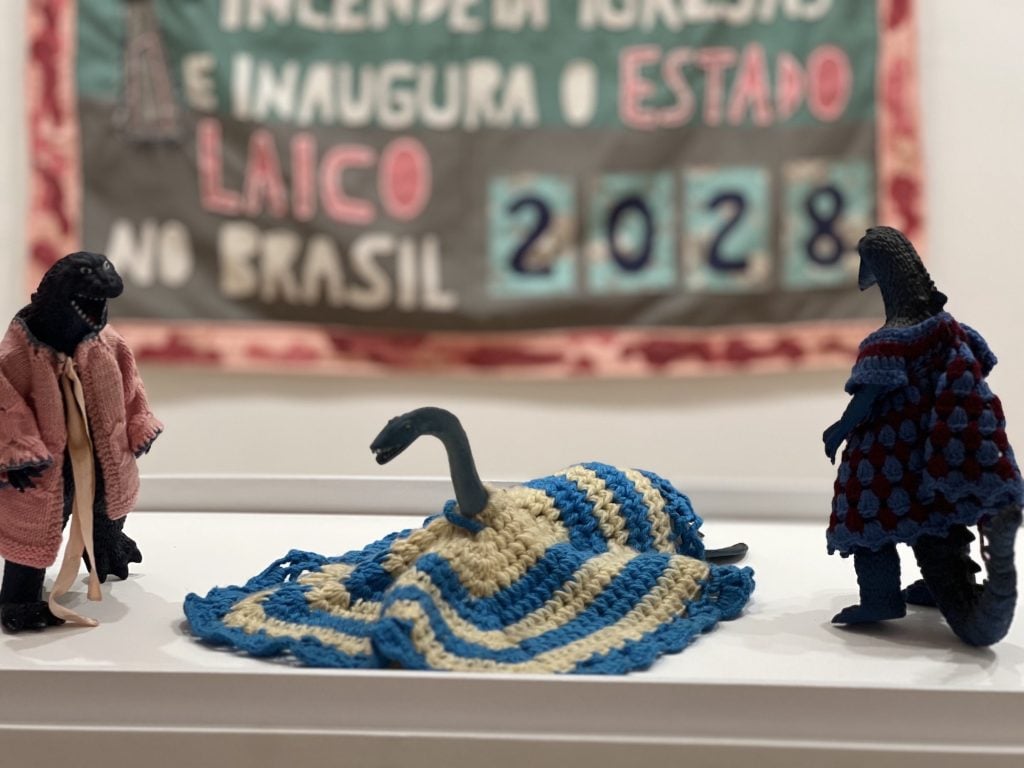
Feliciano Centurión, Untitled, from the series Familia (Family), (1990) as part of “Spin A Yarn”
at Guild Hall in East Hampton, New York.
Other artists in the show use textiles as a way to explore issues ranging from gender discrimination and racial injustice to gun violence. For instance, Feliciano Centurión, an openly gay man, originally from Paraguay but working in Argentina, began producing embroidered and crocheted works on everyday household fabrics, placed alongside toy dinosaurs, to reference illness, sexuality, and death. (The toy dinosaurs reference extinction.)
Meanwhile, social justice is the focus of Yvonne Wells’s large quilt titled A Shadow Over Justice (2004). Both a utilitarian object and a means of memory keeping, the quilt confronts bias in America’s criminal justice system. And DETEXT’s Widowmaker (2020-2022) is a woven rug that upon closer examination is made with nearly 30,000 bullet casings, referencing both policing and the gun industry in the US.
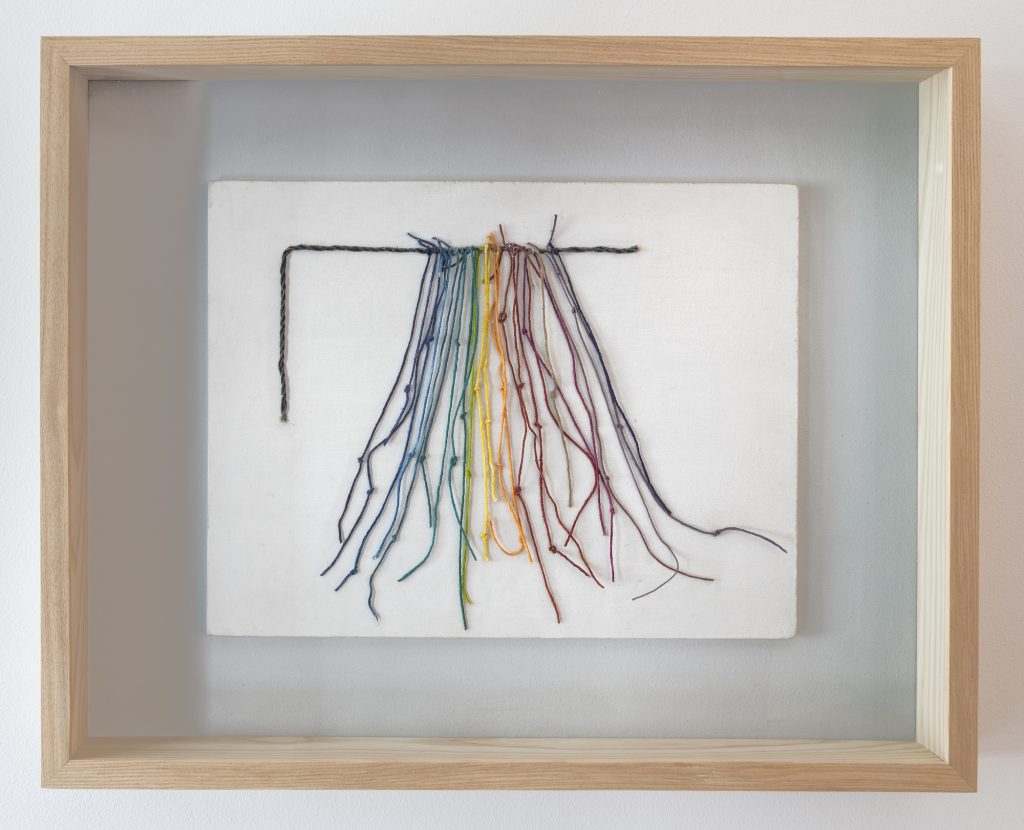
Alejandro Puente Quipu “nudos,” (1971) as part of “Spin A Yarn” at Another Space in Chelsea, New York.
Another Space in Chelsea, where I saw this show, is a nonprofit established by Estrellita and her husband Daniel, dedicated to building recognition and international awareness to artists from Latin America and its diaspora within a global context.
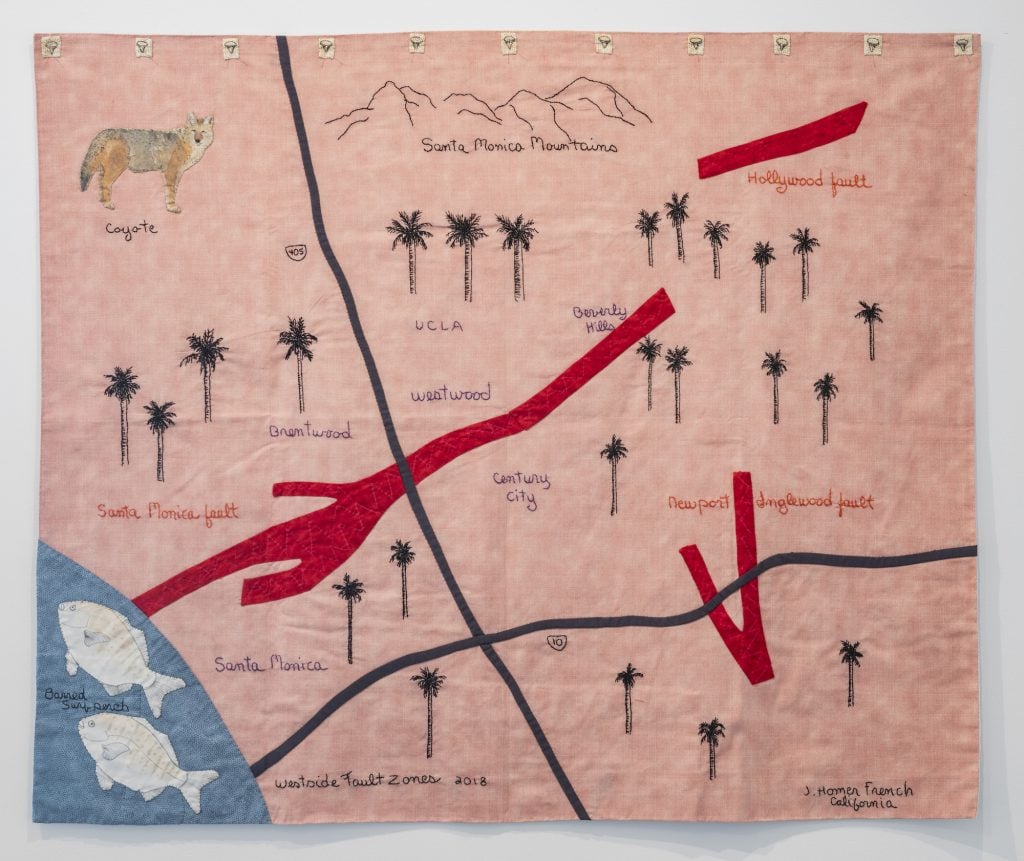
Jessie Homer French, Westside Fault Zones Mapestry, (2018) as part of of “Spin A Yarn” at Another Space in Chelsea, New York.
Said Estrellita: “I am particularly excited to be partnering with Guild Hall in East Hampton, a museum in an area where the Latino community plays an important role and that is free to the public.”